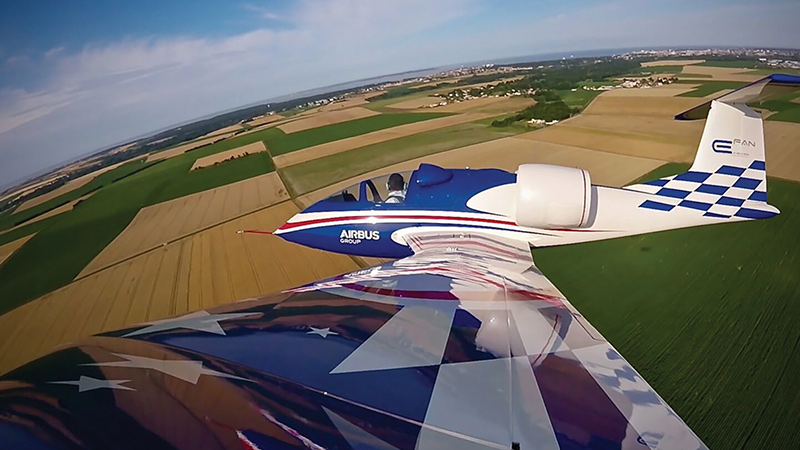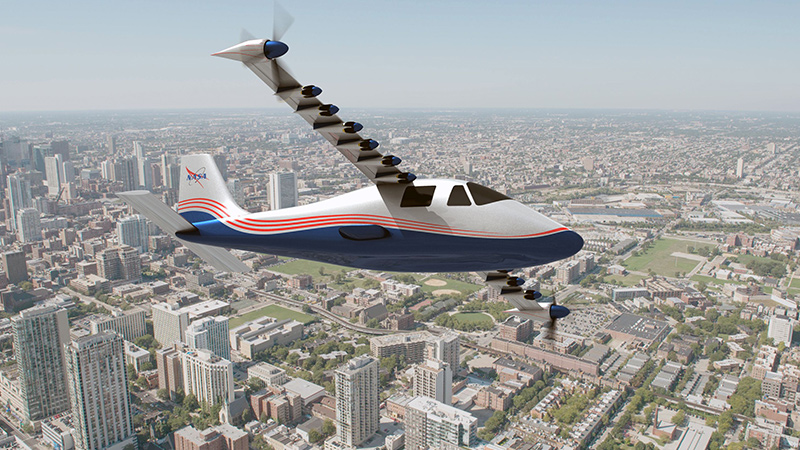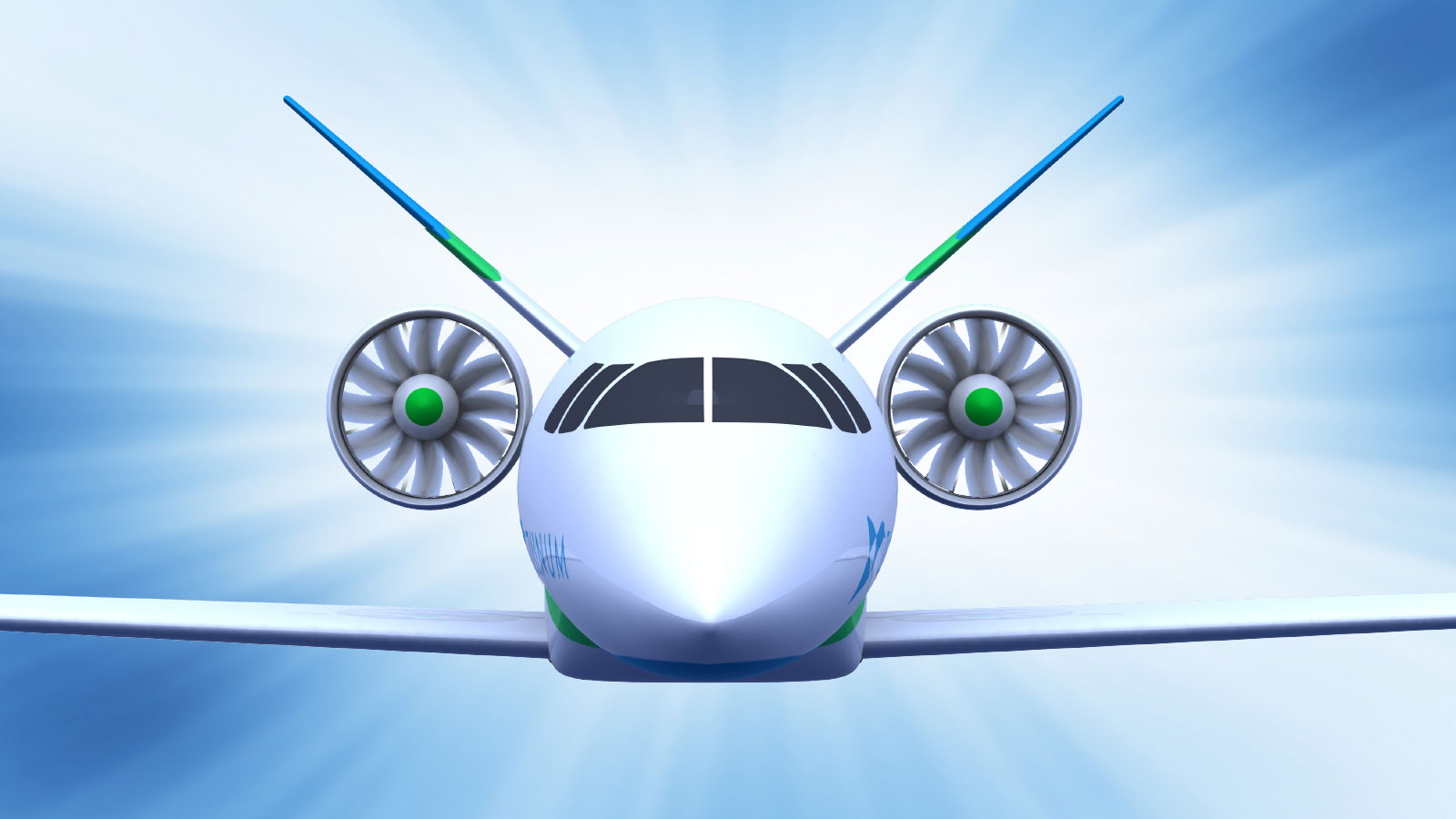Stay Up to Date
Submit your email address to receive the latest industry and Aerospace America news.
Reinvigorating short-haul flight with hybrid-electric aircraft
Just as “all roads lead to Rome” in the old saying, nearly all commercial flight paths lead to a hub airport.
Upward of 95 percent of air traffic in the United States goes in and out of around 140 airports — about 1 percent of the 13,000-plus airports throughout the country. For a traveler looking to get from A to B, this lack of local service often tacks on significant additional travel time to one, if not both ends of a trip.
Commercial aviation as we know it, long driven by the economics and engineering demands of fossil fuels, may be ready for a rethink. Leading aerospace firms, as well as tech titans in Silicon Valley, are increasingly placing their bets that this model can be upended by electric propulsion, probably in tandem with internal combustion on aircraft for some years to come.
In this congested airspace, one such startup, Zunum Aero, has tried to set itself apart by targeting what it sees as neglected, regional, short-haul routes, ranging from a few hundred to a thousand miles. In April, the Kirkland, Washington, company unveiled how it plans to usher in a golden era of regional travel in the United States beginning in the 2020s. To pull off the feat, the company foresees an intermediate step focused on hybrid electric aircraft whose propulsion fans would be driven electrically most of the time and by gas-powered turbines when extra power or range are required. If batteries can be improved enough, though, fleet operators could then opt for all-electric aircraft. Zunum thinks that could be as soon as the 2030s, though some experts think that timeline might be optimistic. Meanwhile, Zunum — the name is drawn from the Mayan word for “hummingbird” — is also developing optimization software intended to milk maximum benefit from its electric powertrain.
“Aviation is shaped by the propulsion that you have. We are 70 years into the jet age, and it’s changed our whole lives — we can travel long distances in the country and around the world,” says Ashish Kumar, founder and CEO of Zunum. “Now we are entering an era where you have a second, equally powerful propulsion capability” — electric power — “that we think is going to change the face of transportation, just as the jet has done over a long distance.”
“Our goal,” adds Kumar, “is to be one of the key drivers of that shift.”
E pluribus … Zunum?
It’s a bold vision, and admittedly a mostly unrealized one — Zunum’s aircraft are only in the conceptual stage, with many specifics yet to be named. But Zunum has nevertheless secured financial backing from Boeing HorizonX, a venture capital division of the aerospace firm, as well as airline JetBlue’s Technology Ventures arm. Boeing did not offer further comment for this story, but HorizonX Vice President Steve Nordlund said in an April statement: “Boeing is investing in Zunum because we feel its technology development is leading this emerging and exciting hybrid-electric market space.”
In that statement, Zunum laid out the promise of its approach. By lighting up a vastly underutilized network of regional airports with 10- to 50-seat aircraft, travel times for stretches of a few hundred miles could fall by 40 percent for popular routes, like the one between Los Angeles and Silicon Valley, Zunum says. To take another example: From AIAA’s headquarters in Reston, Virginia, to New York’s La Guardia Airport, door-to-door travel time would be cut in half from 270 to 135 minutes, Zunum estimates. New York-bound customers could fly out of Leesburg Executive Airport, rather than the hub Dulles International Airport, benefiting from the former’s close parking to their flight aircraft, quicker security and baggage screenings, and less taxiing before takeoff. Out-of-the-way connections could see transit times plummet by over 80 percent.
Fares would drop by corresponding amounts, putting many round trips well under $100. Emissions with the initially hybrid aircraft would fall 80 percent compared to conventionally fueled aircraft. Another undesirable — the engine noise from internal combustion engines — would be slashed by three-quarters with an electric drivetrain, according to Zunum.
The company, like others attempting to actualize electric’s revolutionary potential sooner rather than later, has numerous obstacles to overcome. Foremost is the technology at the heart of electric transportation, the battery. Improvements continue to be made, spurred in part by the frenzied state of innovation for hand-held devices, like smartphones, as well as electric cars, like at the still-scaling-up Tesla Gigafactory in Nevada. But when mostly or fully electric flight will become economical is still a matter of debate.
Belying Zunum’s optimism, for instance, is a 2016 National Academies of Sciences, Engineering and Medicine report, commissioned by NASA to focus its efforts on commercial aviation carbon reduction (covered in Aerospace America’s October 2016 issue). The report’s committee members concluded that battery-powered regional passenger aircraft are unlikely to fly within 30 years. “We obviously disagree,” says Matt Knapp, a founder of Zunum and its chief engineer. “We think their battery forecast is probably conservative.” Knapp explains that the committee “tapped all the usual engine makers, who don’t really have a vested interest in saying anything other than, ‘let’s develop more efficient engines.’”
While the traditional major engine firms are indeed looking to squeeze more out of traditional internal combustion engines, to varying degrees they are keeping an eye on not getting left behind by electric’s potential disruption. Rolls-Royce, for example, is seriously developing hybrid-electric systems. At any rate, the majors are not battery makers, and will only go as far as energy storage limits allow.
“If we had miracle batteries — just amazing, amazing batteries — then it would be a no-brainer. Everybody would do everything electric,” says Rob McDonald, an aerospace engineering professor at California Polytechnic State University in San Luis Obispo, and a member of AIAA’s Electric Aircraft/Hybrid Electric Propulsion Working Group. “But we don’t have miracle batteries yet, so the interim question becomes, ‘what kind of vehicles can you do?’”
In it for the short haul
For many aerospace firms and startups, the answer to that question is to think “small.” Airbus is test flying a two-seat, hybrid-electric demonstrator in its E-Fan program. The France-based firm is also looking into relieving car congestion in megacities via drone-like vehicles through its CityAirbus initiative. Meanwhile, Uber — the ride-hailing service for cars — is pushing for vertical, takeoff-or-landing urban shuttlecraft, more akin to helicopters.
Numerous other organizations have gotten involved in the hybrid-electric aircraft space, including NASA with its envelope-pushing X-57 demonstrator, now in construction. For the major aerospace firms, insights gleaned by pursuing modestly sized and purposed aircraft could then set the stage for electrifying long-haul aircraft decades down the road.
Zunum’s Kumar, however, thinks the economic case is strong enough now for skipping ahead to larger, multiseat craft. The unexploited market for short-haul routes — covering a thousand miles or less between small cities and suburban areas, historically serviced by aircraft like the aging 10-seat Cessna 402 — has long been recognized through research by NASA and other interested parties.
“There is the potential here to open up high, latent demand,” says Brian German, an aerospace engineering professor at Georgia Tech and also a member of the AIAA electric/hybrid working group. “People don’t know they want this now because it doesn’t exist, and if you could open that up, a lot of trips people would take by car could get pushed into aviation.”
Kumar says he does not see his company’s main competition as other aircraft makers or carriers; instead, “the real battle is between aircraft and ground vehicles,” he says.
Statistics from the U.S. Department of Transportation’s National Household Travel Survey bear this out. The survey reports that about 95 percent of domestic trips under 500 miles are taken by car, plus a still-appreciable 42 percent of trips in the 750- to 1,000-miles range. Kumar says analyses conducted by Zunum and for high-speed rail as a general short-haul transportation suggest 7 percent to as much as 15 percent of those long road trippers could be peeled off into paying airline customers.
The regional air market could certainly use the shot in the arm. In the 1980s, Kumar says, nearly 300 operators flew traditional 20-seat planes. Nowadays, 60-some operators fly mostly 80-seat aircraft. While overall air travel in the U.S. keeps setting records year-on-year, regional air travel is stuck at 2005 levels, at around 150 million annual passengers, amid dwindling departures and operator profit margins — not to mention a chronic pilot shortage.
Because fossil fuel-based propulsion systems benefit from altitude and speed, slower and lower-flying 50-seaters cannot compete in cost per passenger miles with long-haul aircraft ferrying hundreds of travelers. “Fuel is a big part of the operational cost pie chart,” says German.
Electric motors and batteries might just flip this equation. By taking energy off the grid at discounted bulk prices and in advantageous regions of the country with low electricity costs, an operator “could pay energy costs a good bit lower than aviation gasoline,” says German.
Kumar believes that if he develops the Zunum aircraft, both operators and customers will come, as in the film “Field of Dreams.” “What happened to our air system doesn’t have to do with demand,” Kumar says. “It has to do with supply.”
Something old, something new
Zunum’s aircraft remains very much in the intensive design phase. Yet the company has arrived at what it feels are some firm decisions moving forward to meet its goals.
Take the propulsion system. A propeller will be positioned within a cylindrical housing. Two of these ducted fans will likely be mounted near the rear of the aircraft, giving it a look that does not dramatically depart from today’s business jets. The fans will be offset from the fuselage to cut down on noise inside the cabin, a chief complaint Kumar and his colleagues have heard from veteran passengers of small planes. People in neighborhoods unaccustomed to airplanes zooming overhead may be surprised at how quiet the design is, Zunum predicts. “Ducted fans are the best way to get low noise and short takeoff in a high-performance package,” says Knapp.
What will the batteries initially be like? Although Zunum tentatively plans to go with a lithium-ion variety, with so many promising chemistries in development in labs worldwide, the company wants to keep its options open. “The battery space is changing so fast that we can’t afford to commit to one specific chemistry,” says Kumar. “We have to design an aircraft that is agnostic to chemistry.”
Zunum has a hand in molding these next-generation batteries. A co-founder, Kiruba Haran, is an electrical engineering professor at the University of Illinois Urbana-Champaign. The university leads a National Science Foundation-funded research group known as the Center for Power Optimization of Electro-Thermal Systems, or POETS, which includes scientists from Howard University in Washington, D.C., Stanford and the University of Arkansas, as well as industry partnerships with Zunum and Boeing. POETS’ goal: To substantially increase the energy density of batteries, such that a reasonable amount of the cells — not too heavy, not too voluminous — could provide enough juice for hybrid or purely electric flight. Out of the gate, Kumar says Zunum will conservatively assume an energy density of at least 300 watts per kilogram, about what today’s best lithium-ion batteries are starting to reliably muster, though increases from there will be where the hybrid concept really starts to take wing.
Beyond batteries, Zunum must master energy management, which refers to when the aircraft will semi-autonomously toggle between batteries and gas turbines for efficiency. Engineers have made advances in this area before with municipal hybrid-electric buses, for instance. Building from there, Zunum’s engineers are devising software that will decide when to drive the fans with internal combustion, such as when maximum power is required, and when to drive them electrically. The software will run queries every several minutes, before and during flight. It will integrate information from the batteries, fuel tanks and turbines with real-time flight data and weather reports. Adjustments will be made on the fly, as it were, optimizing the aircraft’s performance and flight path. “When you’re hitting your actuals, like running into wind, or you need to deviate from your original flight path, platform will recompute what is the optimized energy plan for that flight,” says Kumar.
Zunum’s principals have secured a patent for some of the intellectual property behind this software, as well as their broader systems and methods for “overcoming the disadvantages of the current air transportation system,” as the patent states.
Aside from these deeper technical challenges, Zunum is also working alongside other companies with the FAA to create an electric aircraft certification framework, expected sometime next year. Historically, many innovative aircraft concepts have foundered at this stage, given the toughness of the relevant FAA regulations for introducing new technologies. “Lack of certification experience and financing is where a lot of ideas come apart at the seams,” says German. He adds, though, that Zunum might well have a leg up in clearing this hurdle. “The Boeing connection [with Zunum] could extend beyond investment to technical expertise,” German says, “and if anyone knows how to certify an airplane, it’s Boeing.”
Furthermore, a lot has changed in the political climate since Zunum’s founding in 2013. Although the Trump administration’s priorities run counter to those of the former Obama administration on promoting clean energy and addressing climate change, Kumar says that the trajectory envisioned for Zunum does not depend on government regulation or on R&D funding.
Pie in the sky?
Zunum and the other entrants to the nascent hybrid and electric aircraft field have a lot to prove before taking to the skies as viable enterprises. A note of caution is warranted, given how staid the commercial aircraft paradigm has been for decades. Indeed, the frothiness of the electric-hybrid scene has made skeptics out of some analysts, such as Richard Aboulafia, vice president for analysis at the Teal Group, an aerospace and defense industry research firm in Virginia. He dismisses the recently proliferating artists’ impressions of supposedly game-changing aircraft as just “1950s Popular Mechanics cover stories.”
“The essence of futurism is the tendency to overstate the impact and readiness of exciting new technologies,” says Aboulafia. “We’re just mainlining that futurism.”
Just as the jet engine shook up aviation, eventually something else is fated to as well, and the industry as we know it will change. The inevitable transition to what’s next, via hybrid drivetrains, could be right around the corner.
“Hybrids are compelling as an intermediate step, as a stopgap,” says Cal Poly’s McDonald. “But so many things will be enabled by electric. It will be transformational.”
Aerospace America staff reporter Tom Risen contributed to this story.
NASA’s air apparent
Zunum’s approach of mixing internal combustion with electric power to create a hybrid-electric passenger plane is among the more conservative propulsion concepts in the emerging sector. NASA is taking an even bolder approach with its X-57 experimental aircraft, nicknamed Maxwell. Plans call for placing 12 small electric motors with propellers on the leading edges of the plane’s wings for maximum power during takeoff, bookended by two larger motors at the wing tips for cruising. The unorthodox arrangement should generate more lift and ultimately a five-fold cut in energy use at high speeds compared to conventional propulsion systems. A test flight of this modified Tecnam P2006T two-seater may happen as soon as this year.
“Now we are entering an era where you have a second, equally powerful propulsion capability that we think is going to change the face of transportation, just as the jet has done over a long distance.”
Ashish Kumar, founder and CEO of Zunum
About Adam Hadhazy
Adam writes about astrophysics and technology. His work has appeared in Discover and New Scientist magazines.
Related Posts
Stay Up to Date
Submit your email address to receive the latest industry and Aerospace America news.






